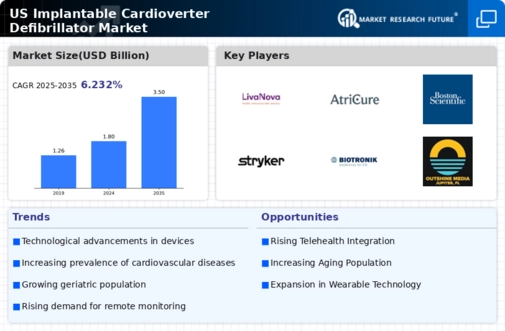Growing Geriatric Population
The growing geriatric population in the US is a significant driver of the implantable cardioverter-defibrillator market. As individuals age, the risk of developing heart-related conditions increases, necessitating effective interventions such as implantable cardioverter-defibrillators. The US Census Bureau projects that by 2030, all baby boomers will be over 65 years old, leading to a substantial rise in the number of elderly patients requiring cardiac care. This demographic shift is likely to result in heightened demand for implantable cardioverter-defibrillators, as healthcare systems adapt to meet the needs of an aging population. Additionally, the focus on preventive healthcare among older adults may further drive the adoption of these devices, as they are seen as essential tools for managing heart health.
Supportive Reimbursement Policies
Supportive reimbursement policies significantly influence the implantable cardioverter-defibrillator market. In the US, Medicare and private insurers often cover the costs associated with these devices, which can exceed $30,000. This financial support encourages healthcare providers to recommend implantable cardioverter-defibrillators as a viable treatment option for patients at risk of sudden cardiac arrest. As reimbursement policies evolve to include newer technologies and indications, the market is likely to experience growth. Furthermore, the establishment of value-based care models may incentivize healthcare providers to adopt these devices, as they can lead to improved patient outcomes and reduced long-term healthcare costs. The alignment of reimbursement strategies with clinical guidelines is expected to bolster the market further.
Rising Incidence of Cardiac Diseases
The increasing prevalence of cardiac diseases in the US is a primary driver for the implantable cardioverter-defibrillator market. According to the American Heart Association, cardiovascular diseases account for approximately 697,000 deaths annually, highlighting a critical need for effective treatment options. As the population ages, the incidence of conditions such as arrhythmias and heart failure is expected to rise, leading to a greater demand for implantable cardioverter-defibrillators. This trend suggests that healthcare providers will increasingly recommend these devices as a preventive measure against sudden cardiac arrest, thereby expanding the market. Furthermore, advancements in diagnostic technologies may lead to earlier detection of heart conditions, further propelling the need for these devices in clinical settings.
Increased Focus on Preventive Healthcare
An increased focus on preventive healthcare is emerging as a key driver for the implantable cardioverter-defibrillator market. Healthcare providers and patients alike are recognizing the importance of early intervention in managing cardiovascular health. This shift towards prevention is likely to result in more patients being screened for arrhythmias and other heart conditions, leading to higher rates of implantable cardioverter-defibrillator implantation. Furthermore, public health campaigns aimed at educating individuals about the risks of heart disease and the benefits of early detection may contribute to increased awareness and acceptance of these devices. As preventive healthcare becomes a priority, the market for implantable cardioverter-defibrillators is expected to expand, reflecting a broader trend towards proactive health management.
Technological Innovations in Device Design
Technological innovations play a crucial role in shaping the implantable cardioverter-defibrillator market. Recent advancements have led to the development of smaller, more efficient devices that offer enhanced functionality and patient comfort. For instance, the introduction of subcutaneous implantable cardioverter-defibrillators has provided a less invasive option for patients, which may lead to increased adoption rates. Additionally, improvements in battery life and remote monitoring capabilities are likely to enhance patient outcomes and satisfaction. The market is projected to grow as manufacturers continue to invest in research and development, aiming to create devices that are not only more effective but also easier to implant and manage. This ongoing innovation is expected to attract a broader patient demographic, further driving market expansion.




















Leave a Comment